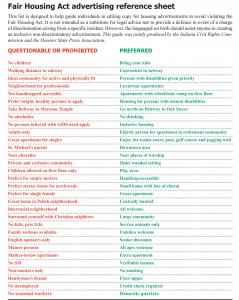The federal act was passed by Congress in 1968 and 1988 and is administered by the U.S. Department of Housing and Urban Development.

The Indiana Fair Housing Act was passed in 1990.
Who the acts affect:
- Renters or sellers of property.
- Agents involved in rental or sale of property.
- Advertising media.
Fair Housing Act lawsuits involving advertising can be filed against not only the person who wrote and placed an ad but also the owner and management of the property and the newspaper management, publisher and owner.
Who’s not included:
- Building with no more than four units with owner living in one of the units.
- Owner of single-family home.
But the act will apply if property owners use a real estate broker and/or discriminatory advertising.
Who can complain:
- Individuals who feel they have been discriminated against.
- HUD and other local, state and federal agencies.
- Fair housing organizations (can be testers).
Penalties:
- Fines can range from $10,000 to $50,000.
Relationships:
- The law changes the relationship between newspapers and real-estate agents because the law requires newspapers to enforce the Fair Housing Act.
Seven classes of discrimination:
- Race
- Color
- Religion
- Sex
- National origin
- Handicap
- Familial status.
Rule to live by: Describe the property in an ad, not who might live there. For example:
Family status:
- Families with children are protected.
- A family can be one person, for example, a pregnant woman or person adopting a child.
- Advertisers can’t define the size of a family or relationships. For example, they can’t say who will sleep in which bedrooms.
- Use caution with:
- Specifying the number of children allowed. A landlord can limit occupancy but it must be “reasonable.”
- Specifying “senior citizens.” A specific exemption exists, but otherwise it could be discriminatory against children.
- Specifying “students.” It could be interpreted as singles only and no children wanted.
“Senior citizen” tags are exempt if homes are:
- Intended for and 100 percent occupied by people 62 years or older.
- Intended and operated for an occupancy of 80 percent by at least one person 55 or older.
- Intended and operated to assist the elderly under a state or federal program.
Race, color, national origin or religion:
- Don’t use phrases such as “No Asians” or “English-speakers only.”
- Don’t use churches as directional landmarks, for example, “near St. Patrick Church.”
Handicapped:
- Caution: Using the term “active” may indicate to a handicapped individual that the landlord doesn’t want people who use wheelchairs, have visual impairments, etc.
- Describe amenities – “tennis courts, pool” – not who will use them.
Pet restrictions:
- Landlords can’t charge an additional, non-refundable fee or excessive deposit for animals who assist people with handicaps; it’s questionable whether they can charge any deposit at all.
Sex or sexual discrimination:
- Caution: Use caution with terms such as “Fisherman’s retreat.” Does this imply no women?
- Sexual restrictions are allowed with a common use of a bathroom or bedroom by unrelated people of the opposite sex.
Personal habits:
- It’s OK to specify that habits such as smoking or drinking as not acceptable, but it’s dangerous to say “non-smokers” or “non-drinkers.”
- Ads can discriminate against drug users or any illegal activity but not against people in recovery, such as former alcoholics or addicts.
- Terms like responsible, quiet and stable are vague and could be construed as discriminatory.
Proximity:
- Caution: Use caution with terms such as “close to,” “near” and “within walking distance to” places such as a Catholic high school or country club that discriminates. Does it convey a message beyond location? Does “walking distance” discriminate against those who use a wheelchair?
- It’s better to say “three blocks from” or “a half-mile from.”
Property descriptions:
- Caution:Use caution with terms like:
- “Handyman’s dream” – sex or number of people in question?
- Grandma’s house – family or sex in question?
- Mother-in-law quarters – number or sex in question?
- Private – Is this a description or a message about race or other factors?
Catchwords:
- Caution: Use caution with terms like “desirable neighborhood,” “prestigious,” “restricted” and “secure.” Are they descriptions or messages?
Other descriptions:
- It’s OK to filter candidates by their ability to pay, but the source of income should not be an issue.
- Can’t say “must be employed.” A handicapped person may be unemployed but have income.
- Don’t describe landlord.
- Don’t use restrictive park or complex rules.
Art:
- Don’t use pictures that could discriminate, such as white couples or men only.
- Do show that children and minorities are accepted.
Display ads:
- Include either:
- The slogan “Equal Housing Opportunity” for ads less than 4 inches.
- Or use the slogan and logo:
- For ads four column inches to 1/8 page, slogan and logo must be ½ by ½.
- For ads 1/8 page to ½ page, they must be 1 by 1.
- For ads ½ page or larger, they must be 2 by 2.
- If ad uses other logos, the Equal Housing Opportunity logo should be equal to the largest of the other logos.
- May substitute statement for ads larger than four column inches.
